A) 10,000 years ago.
B) 100,000 years ago.
C) 1.1 million years ago.
D) 1,000 years ago.
E) 10 million years ago.
Correct Answer

verified
Correct Answer
verified
Multiple Choice
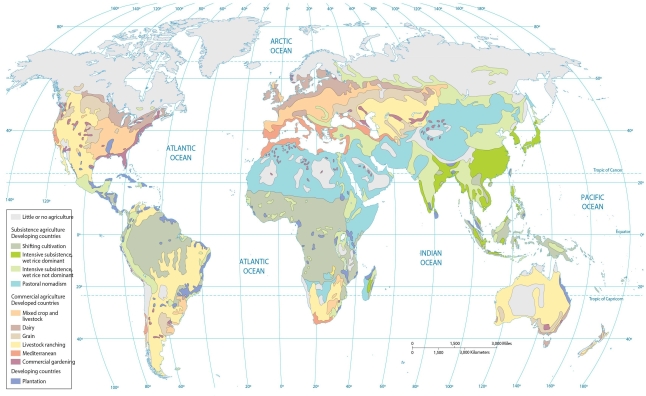 -Judging from the map of agricultural regions, which type of agriculture occupies the largest percentage of eastern India?
-Judging from the map of agricultural regions, which type of agriculture occupies the largest percentage of eastern India?
A) mixed crop and livestock
B) intensive subsistence
C) shifting cultivation
D) pastoral nomadism
E) plantation
Correct Answer

verified
Correct Answer
verified
Multiple Choice
The type of agriculture practiced near large cities, which includes producing fruits and vegetables, is called
A) sawah.
B) truck agriculture.
C) subsistence agriculture.
D) truck farming.
E) truck hybridization.
Correct Answer

verified
Correct Answer
verified
Multiple Choice
A major practice of sustainable agriculture is
A) agribusiness.
B) an increased "green revolution" use of chemicals.
C) the lack of integration of crops and livestock.
D) use of pesticide resistant seed.
E) limited use of chemicals
Correct Answer

verified
Correct Answer
verified
Multiple Choice
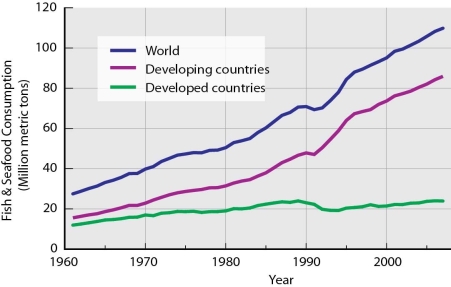 -According to the graph on the growth in human consumption of fish, in about the year 2005, the amount of fish consumed by developing countries exceeded
-According to the graph on the growth in human consumption of fish, in about the year 2005, the amount of fish consumed by developing countries exceeded
A) 80 million metric tons.
B) 20 million metric tons.
C) 60 million metric tons.
D) 100 million metric tons.
E) 70 million metric tons.
Correct Answer

verified
Correct Answer
verified
Multiple Choice
Potatoes were domesticated in
A) Southeast Asia.
B) Southwest Asia.
C) Ethiopia.
D) northern China.
E) the Americas.
Correct Answer

verified
Correct Answer
verified
Multiple Choice
Truck farming is a term that derives from the Middle-English word truck, meaning
A) "cart."
B) "mobility" or "movement."
C) "subsiding" as in "subsistence agriculture."
D) "bartering" or "exchange of commodities."
E) "horse" or "horse-drawn."
Correct Answer

verified
Correct Answer
verified
Multiple Choice
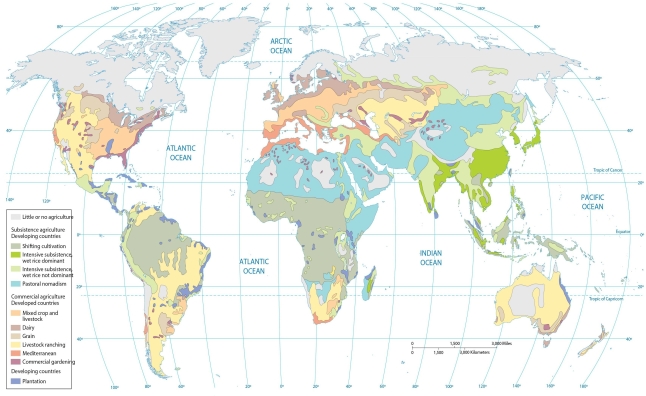 -As indicated by the map of agricultural regions, the largest proportion of farmers in Asia practice
-As indicated by the map of agricultural regions, the largest proportion of farmers in Asia practice
A) hunting and gathering.
B) intensive subsistence.
C) pastoral nomadism.
D) shifting cultivation.
E) plantation agriculture.
Correct Answer

verified
Correct Answer
verified
Multiple Choice
In the winter wheat area of the U.S., the crop is planted in
A) autumn and harvested in summer.
B) winter and harvested in spring.
C) winter and harvested in autumn.
D) spring and harvested in summer.
E) spring and harvested in autumn.
Correct Answer

verified
Correct Answer
verified
Multiple Choice
Which statement correctly describes hunting and gathering?
A) All humans began to obtain their food this way after agriculture was invented.
B) It is a form of nomadism that disappeared in the late 1900s after the fall of the Soviet Union.
C) This form of subsistence disappeared in the mid-1900s owing to industrialization and modernized agriculture.
D) Hunter gatherers cannot live for long in groups of less than 100 people owing to the necessary division of labor.
E) This form of subsistence is still practiced despite the modernization of agriculture in some areas.
Correct Answer

verified
Correct Answer
verified
Multiple Choice
 -A choropleth map such as the map of "Income Spent on Food" might conceal details such as which of the following?
-A choropleth map such as the map of "Income Spent on Food" might conceal details such as which of the following?
A) Even in developed countries where the average person spends less than 20 percent of their income on food, inequalities of income may be great enough for many people to remain undernourished.
B) In developed countries where the average person spends less than 20 percent of their income on food, the average upper-class person may spend more than 40 percent of their income on food.
C) Even in developed countries where the average person spends less than 20 percent of their income on food, less food is available than in developing countries.
D) Even in developing countries where the average person spends more than 40 percent of their income on food, wealthy people must also spend more than 40 percent of their income on food.
E) In developed countries where the average person spends more than 40 percent of their income on food, other prices are so low that undernourishment is hardly ever a problem.
Correct Answer

verified
Correct Answer
verified
Multiple Choice
The number of farms in the United States declined from about 6 million in 1940 to ________ in 1980.
A) 2 million
B) 5.5 million
C) 10 million
D) 1 million
E) 20,000
Correct Answer

verified
Correct Answer
verified
Multiple Choice
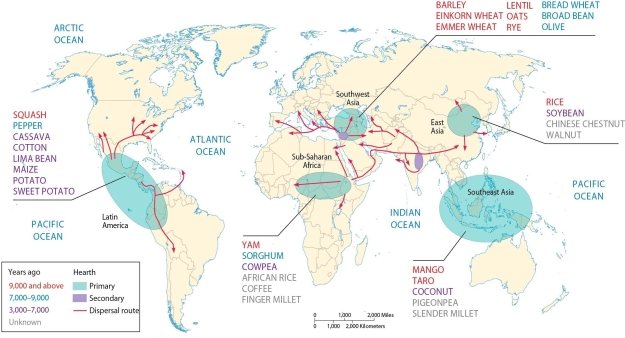 -The map of crop hearths indicates that
-The map of crop hearths indicates that
A) coconuts, pigeonpeas, mango, and taro were first domesticated in Southeast Asia.
B) specific crops can be grown only in and near their crop hearths.
C) potatoes, peppers, and sorghum were first domesticated in Europe.
D) potatoes, peppers, squash, soybeans, and rice were first domesticated in the Americas.
E) soybeans, rice, squash, coconuts, and sorghum were first domesticated in East Asia.
Correct Answer

verified
Correct Answer
verified
Multiple Choice
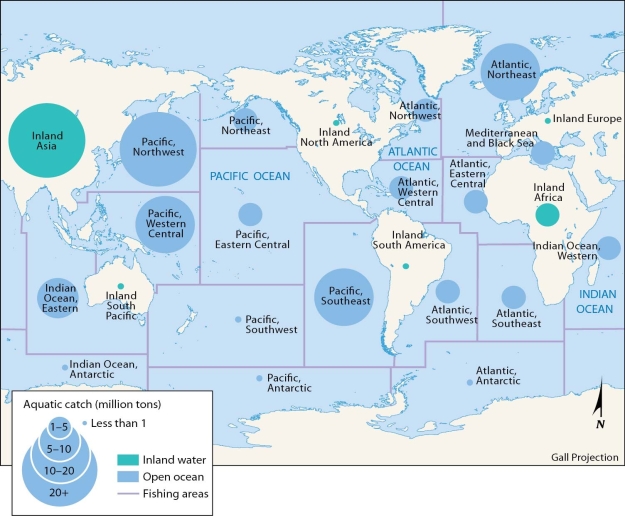 -According to the map of major world fishing regions, the Antarctic section of the Pacific Ocean annually contributes
-According to the map of major world fishing regions, the Antarctic section of the Pacific Ocean annually contributes
A) less than 1 million tons of aquatic catch.
B) 10 to 20 million tons of aquatic catch.
C) 5 to 10 million tons of aquatic catch.
D) 1 to 5 million tons of aquatic catch.
E) more than 20 million tons of aquatic catch.
Correct Answer

verified
Correct Answer
verified
Multiple Choice
The primary factor in von Thünen's model for choosing commercial farm products is
A) land price.
B) market location.
C) climate.
D) soil character.
E) labor cost.
Correct Answer

verified
Correct Answer
verified
Multiple Choice
Pigs were domesticated in
A) Southeast Asia.
B) South America.
C) Ethiopia.
D) northern China.
E) Southwest Asia
Correct Answer

verified
Correct Answer
verified
True/False
There is consensus among scientists that hunters and gatherers converted to agriculture because of the domestication of animals roughly 12,000 years ago.
Correct Answer

verified
Correct Answer
verified
Multiple Choice
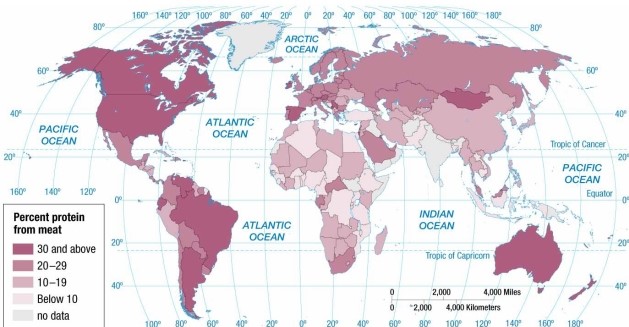 -According to the map of protein from meat, meats provide at least 25 percent of the protein consumed in
-According to the map of protein from meat, meats provide at least 25 percent of the protein consumed in
A) Brazil, Argentina, and Spain.
B) Ethiopia, Iran, and India.
C) Argentina, Australia, and South Africa.
D) Brazil, Australia, and India.
E) Brazil, Canada, and India.
Correct Answer

verified
Correct Answer
verified
Multiple Choice
Which of the following is least likely to be produced in Mediterranean agriculture?
A) butter
B) fruits
C) grapes
D) olives
E) cereals
Correct Answer

verified
Correct Answer
verified
Multiple Choice
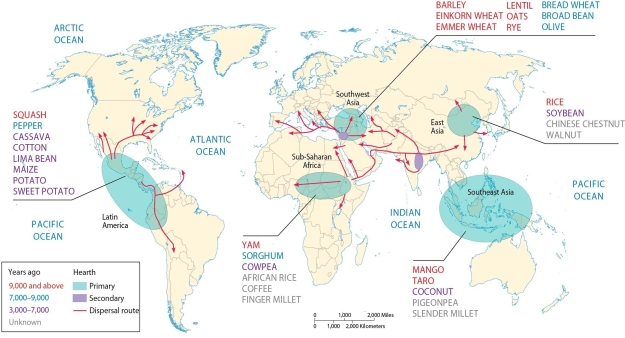 -The map of crop hearths indicates that
-The map of crop hearths indicates that
A) maize, potatoes, squash, and peppers were first domesticated in the Americas.
B) specific crops can be grown only in and near their crop hearths.
C) potatoes, peppers, and sorghum were first domesticated in Europe.
D) coconuts, pigeonpeas, maize, and tomatoes were first domesticated in Southeast Asia.
E) soybeans, rice, squash, coconuts, and sorghum were first domesticated in East Asia.
Correct Answer

verified
Correct Answer
verified
Showing 81 - 100 of 132
Related Exams